FieldWeb Blog.
Get the knowledge and inspiration you need to run your home and commercial service business better.

Starting a lawn care business can be a profitable and rewarding venture, but it requires careful planning and strategy. One of the most important aspects of running a successful lawn care business is pricing your services appropriately. In this guide, we will cover various topics related to lawn care pricing, including factors that affect pricing, types of lawn care services and their pricing, pricing models and strategies, competitive analysis, estimating costs and profits, tips for setting prices, marketing and sales, and customer service and retention. Additionally, we will explore how FSM software like FieldWeb can be useful in managing a lawn care business.
When it comes to pricing lawn care services, there are several factors that you should consider to ensure that your pricing is accurate and competitive. Here are some factors that can affect lawn care pricing:
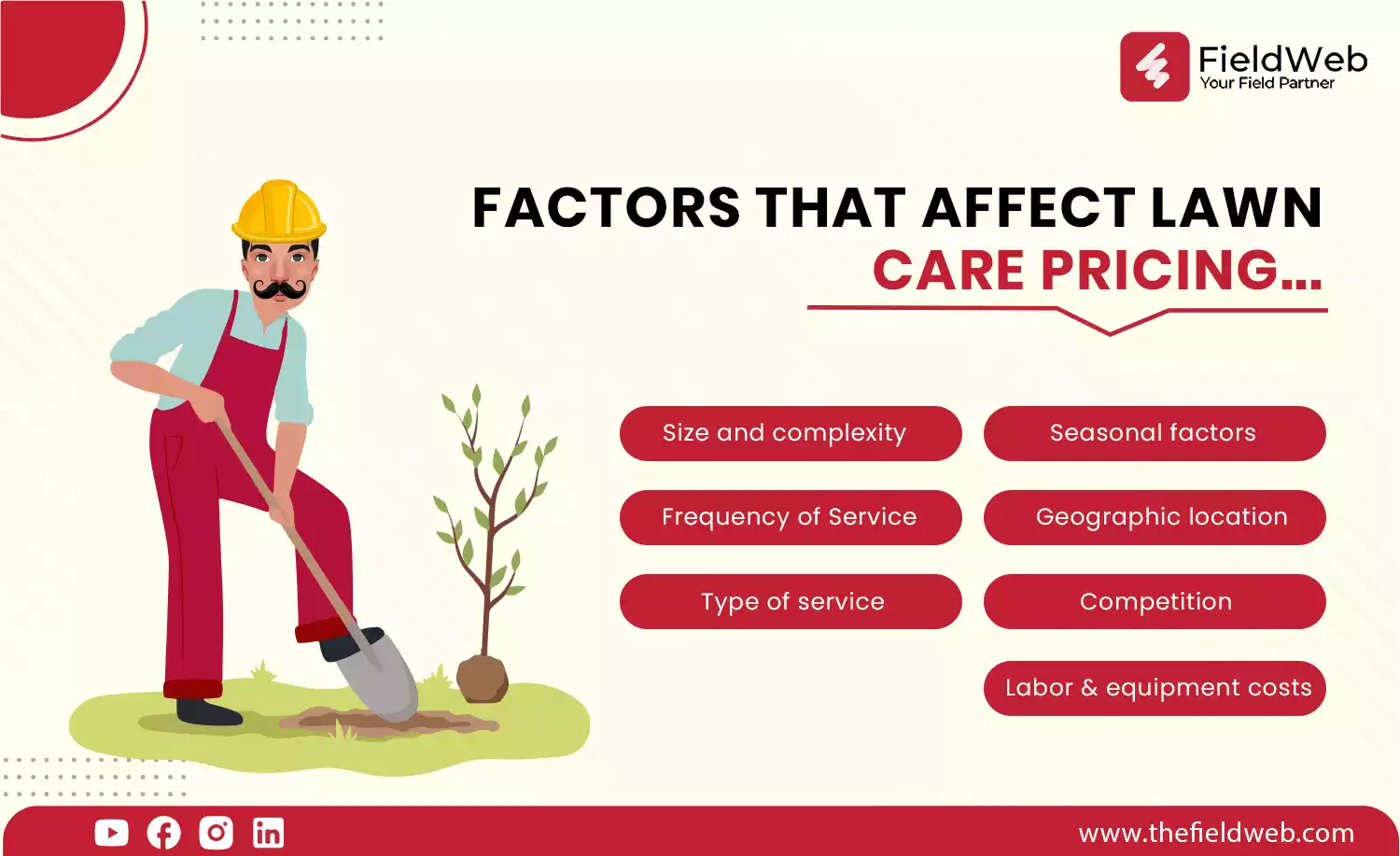
1. Size and complexity of the lawn: The size and complexity of a lawn can significantly impact the time and resources required to complete the job. Larger lawns or lawns with many obstacles, such as trees and flower beds, will require more time and effort and may cost more.
2. Frequency of service: The frequency of service can also affect pricing. Regular lawn maintenance, such as mowing and edging, typically costs less than infrequent or one-time services, such as aeration or overseeding.
3. Type of service: The type of lawn care service being provided can also affect pricing. For example, services such as fertilization, weed control, and pest control require specialized equipment and chemicals, which can impact the cost.
4. Seasonal factors: Seasonal factors, such as weather conditions and the time of year, can also affect lawn care pricing. For example, during the peak growing season, demand for lawn care services may increase, leading to higher prices.
5. Geographic location: The geographic location of the lawn care business can also impact pricing. For example, businesses located in urban areas may have higher overhead costs and may charge more for their services to cover those costs.
6. Competition: The level of competition in the local market can also affect pricing. If there are many lawn care businesses in the area, prices may be more competitive. However, if there are fewer competitors, businesses may be able to charge higher prices.
7. Labor and equipment costs: The cost of labor and equipment is another critical factor in determining pricing. Businesses must consider their operating costs, including wages, fuel, and maintenance costs, when setting prices.
In summary, several factors can affect lawn care pricing, including the size and complexity of the lawn, the frequency and type of service, seasonal factors, geographic location, competition, and labor and equipment costs. By considering these factors and conducting market research, lawn care businesses can set competitive prices and achieve their business goals.
There are several types of lawn care services, each with its pricing structure. Some common services include:

Setting the right price is critical for the success of a lawn care business. Here are some pricing models and strategies that you can use to optimize your pricing:
1. Hourly pricing: Hourly pricing involves charging customers for the amount of time it takes to complete a job. This model is straightforward and easy to implement, but it can lead to unpredictable revenue streams and does not necessarily reflect the value of your services.
2. Flat-rate pricing: Flat-rate pricing involves charging customers a fixed fee for a specific service or bundle of services. This model is simple and predictable for customers and can be more profitable for the business if the pricing is set correctly.
3. Tiered pricing: Tiered pricing involves offering customers different levels of service at different price points. This model can help you appeal to a broader range of customers and provide an upselling opportunity.
4. Value-based pricing: Value-based pricing involves charging customers based on the perceived value of your services. This model requires a deep understanding of your target audience and the benefits of your services.
5. Market-based pricing: Market-based pricing involves setting prices based on the prices of your competitors in the market. This model requires regular monitoring and adjustment to stay competitive.
When choosing a pricing model, it is essential to consider your business goals, target audience, and competition. Here are some pricing strategies that can help you optimize your pricing:

In summary, the key pricing models and strategies for a lawn care business include hourly pricing, flat-rate pricing, tiered pricing, value-based pricing, and market-based pricing. By conducting market research, understanding your costs, bundling services, utilizing technology, and adjusting prices regularly, you can optimize your pricing and achieve your business goals.
To price your lawn care services competitively, it's essential to conduct a competitive analysis of other lawn care businesses in your local market. You can gather information on the services they offer and their pricing structure, as well as their marketing and sales strategies. This information can help you determine how to differentiate your business and set your prices competitively.
To determine the profitability of your lawn care business, you'll need to estimate the costs of providing your services, including equipment, supplies, and labor. You can use industry benchmarks and research to determine typical costs and margins for a lawn care business. Additionally, you can estimate your profits by subtracting your estimated costs from your expected revenue.
Setting prices is one of the most important decisions you will make as a lawn care business owner. If you price your services too high, you may lose customers to competitors. If you price your services too low, you may not be able to cover your costs or make a profit. Here are some tips for setting prices that will help you strike the right balance:
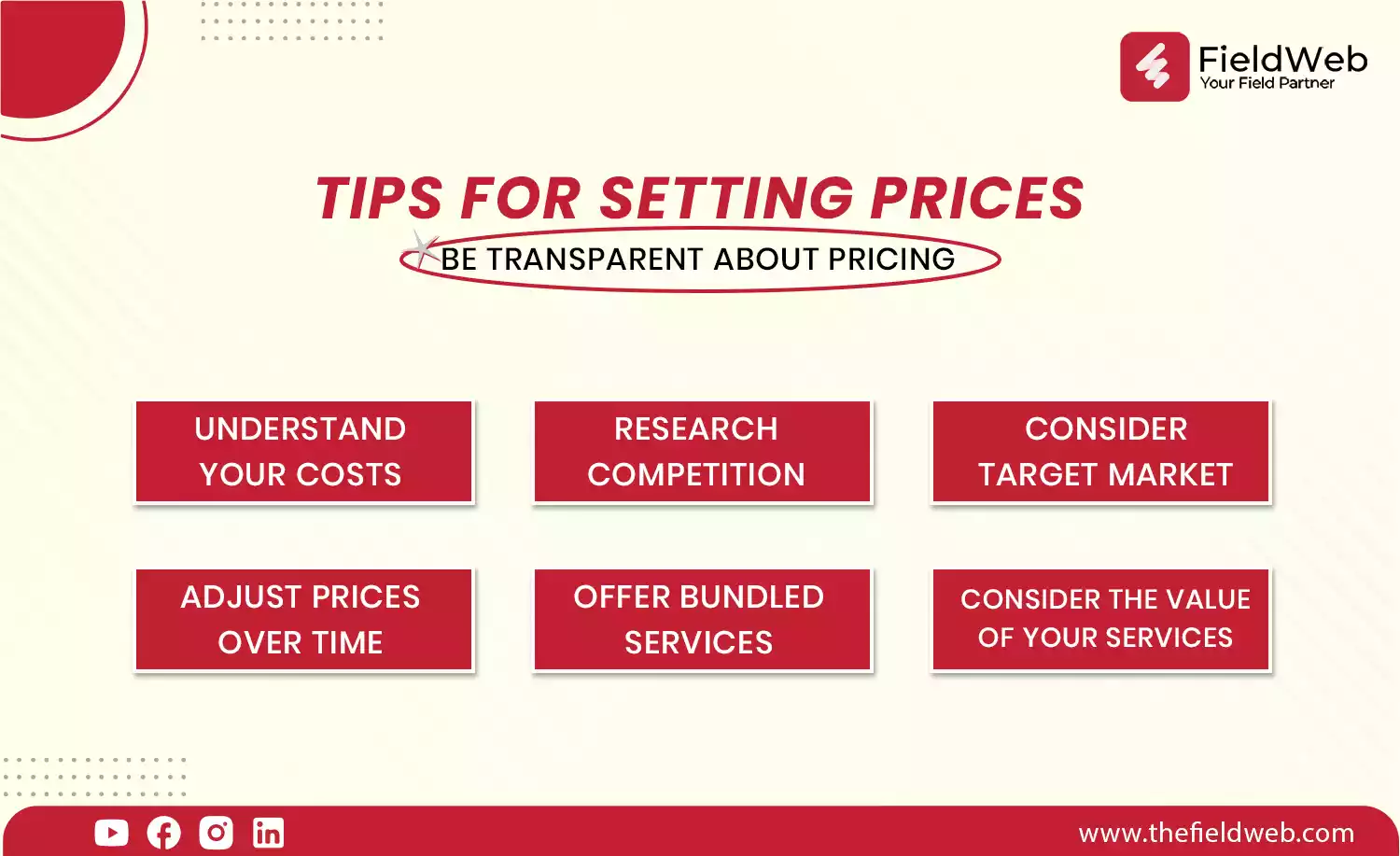
1. Understand your costs: Before you can set prices, you need to understand your costs. This includes not only direct costs such as labor and materials, but also indirect costs such as rent, utilities, and insurance. You should also factor in a profit margin to ensure that you are making a reasonable return on your investment.
2. Research your competition: Researching your competition can give you a sense of the market rates for lawn care services in your area. You can also use this information to differentiate your services and set yourself apart from competitors.
3. Consider your target market: Consider your target market when setting prices. Are you targeting high-end customers who are willing to pay a premium for quality service? Or are you targeting budget-conscious customers who are looking for the lowest price? Your pricing strategy should align with your target market.
4. Offer bundled services: Offering bundled services can be a great way to increase revenue and provide added value to customers. For example, you could offer a package deal that includes mowing, edging, and trimming at a discounted rate.
5. Adjust prices over time: It's important to review your pricing strategy periodically and make adjustments as needed. If your costs increase, you may need to raise your prices to maintain profitability. On the other hand, if you are consistently booking more work than you can handle, you may be able to raise your prices without losing customers.
6. Consider the value of your services: When setting prices, it's important to consider the value of your services. For example, if you use high-quality equipment and offer exceptional customer service, you may be able to charge a premium for your services.
7. Be transparent about pricing: Finally, it's important to be transparent about pricing with your customers. Provide clear, upfront pricing information on your website and in your marketing materials. This can help build trust with customers and reduce the likelihood of disputes or misunderstandings. In summary, setting prices for your lawn care business requires careful consideration of your costs, competition, target market, bundled services, adjustments over time, value of your services, and transparency with customers. By following these tips and regularly reviewing your pricing strategy, you can set prices that are competitive, profitable, and align with your business goals.
Marketing and sales are crucial components of a successful lawn care business. Here are some tips for improving your marketing and sales strategies:
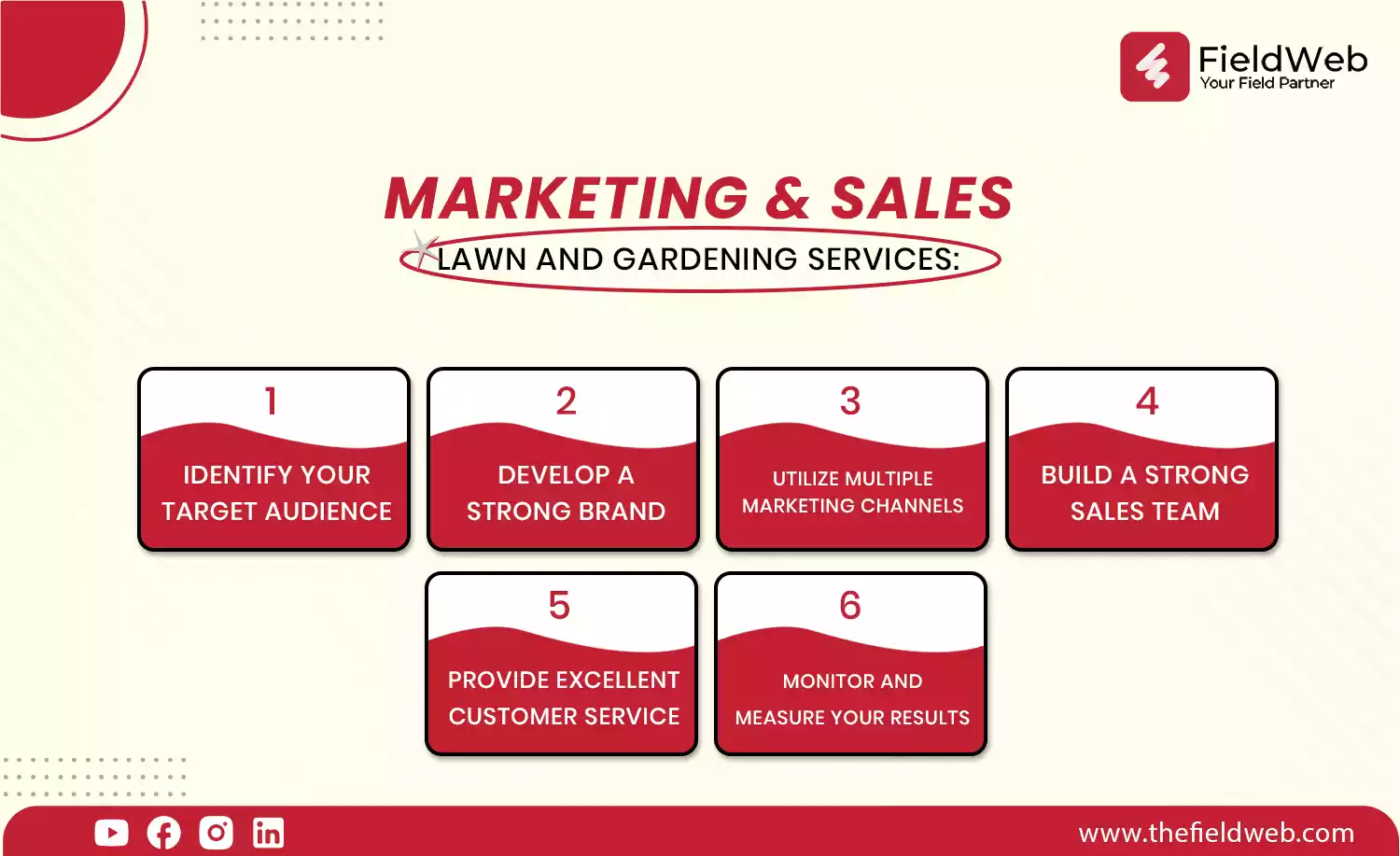
1. Identify your target audience: Understanding your target audience is essential for creating effective marketing and sales strategies. Identify the demographics, geographic location, and psychographics of your target audience, and tailor your messaging and services to their needs and preferences.
2. Develop a strong brand: A strong brand can help you differentiate your business from competitors and build trust with potential customers. Develop a compelling brand identity that communicates your values, mission, and unique selling proposition.
3. Utilize multiple marketing channels: Utilizing a mix of marketing channels can help you reach a wider audience and increase brand awareness. Consider using social media, email marketing, search engine optimization, and paid advertising to promote your services and generate leads.
4. Offer promotions and incentives: Offering promotions and incentives, such as discounts or referral programs, can help generate interest and encourage customers to try your services.
5. Build a strong sales team: A strong sales team is essential for converting leads into customers. Ensure your sales team is knowledgeable, responsive, and able to effectively communicate the value of your services.
6. Provide excellent customer service: Providing excellent customer service is crucial for building trust, generating positive word-of-mouth referrals, and retaining customers. Make sure you prioritize customer service throughout the sales process, from initial inquiries to post-service follow-up.
7. Monitor and measure your results: Regularly monitoring and measuring your marketing and sales efforts can help you identify areas for improvement and adjust your strategies accordingly. Use tools such as Google Analytics or customer relationship management (CRM) software to track leads, conversions, and customer behavior.
In summary, effective marketing and sales strategies for a lawn care business involve understanding your target audience, developing a strong brand, utilizing multiple marketing channels, offering promotions and incentives, building a strong sales team, prioritizing customer service, and monitoring and measuring your results. By implementing these strategies and continuously refining your approach, you can generate leads, convert them into loyal customers, and grow your business.
Customer service and retention are critical for the success of your lawn care business. Providing excellent customer service can help you retain customers, build loyalty, and generate positive word-of-mouth referrals. Here are some tips for improving customer service and retention in your lawn care business:
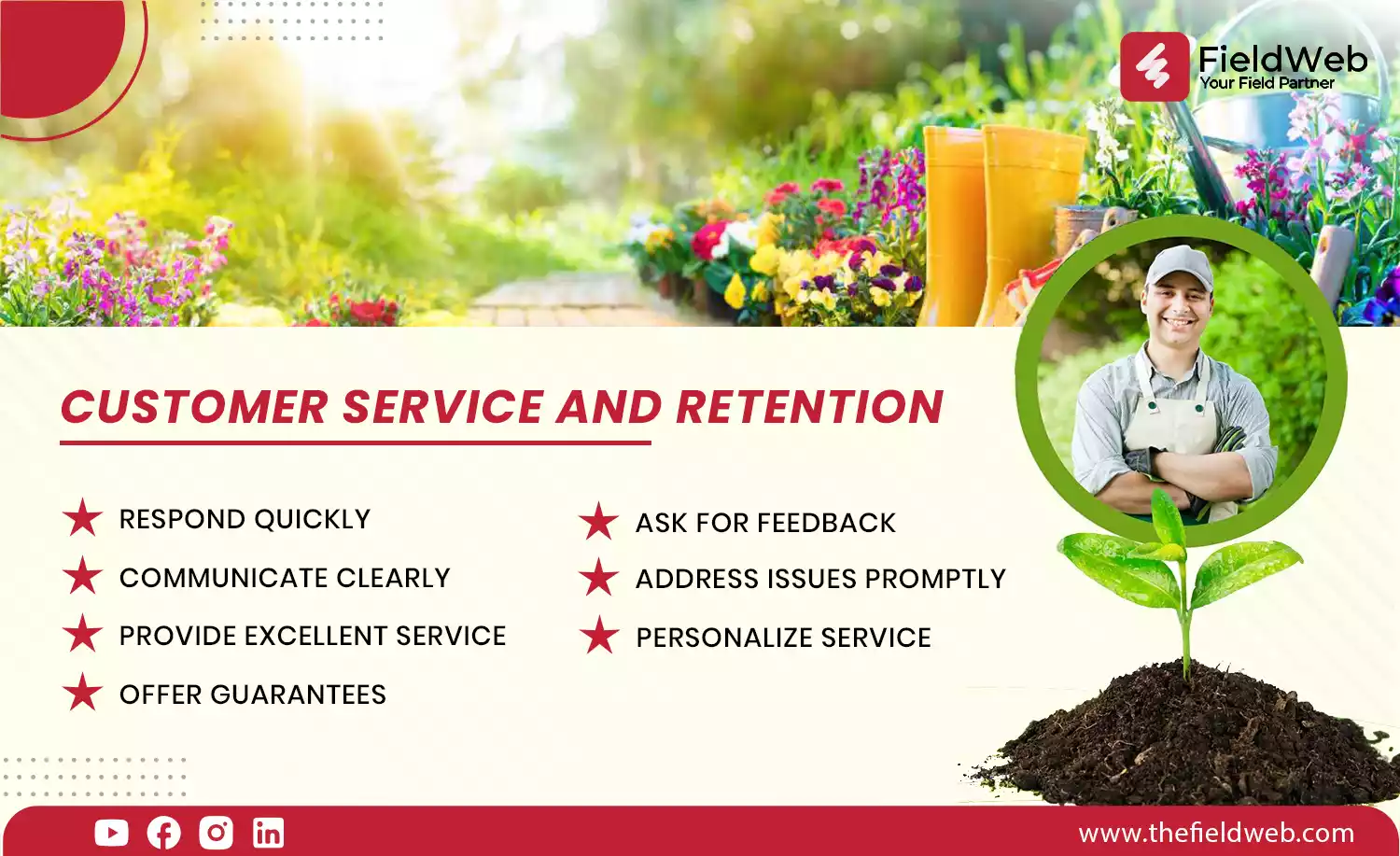
1. Respond quickly: Responding quickly to customer inquiries and requests can go a long way toward building trust and satisfaction. Make sure you have a system in place for promptly responding to customer calls, emails, and messages.
2. Communicate clearly: Clear communication is essential for providing excellent customer service. Make sure you communicate clearly and effectively with customers about pricing, scheduling, and any issues that arise. Consider using tools such as customer portals or messaging apps to improve communication and streamline interactions.
3. Provide excellent service: Providing excellent service is key to retaining customers and building a positive reputation. Make sure your technicians are well-trained, equipped with the right tools and equipment, and able to deliver high-quality services that meet customer expectations.
4. Offer guarantees: Offering guarantees, such as a satisfaction guarantee or a guarantee on workmanship, can help build trust with customers and give them peace of mind knowing they are getting a high-quality service.
5. Personalize service: Personalizing service to meet the unique needs and preferences of your customers can help build loyalty and satisfaction. Consider offering customized service plans or tailoring services to meet specific requests or preferences.
6. Ask for feedback: Asking for feedback from customers can help you identify areas for improvement and demonstrate that you value their input. Consider using customer satisfaction surveys or soliciting feedback through online review platforms.
7. Address issues promptly: If a customer has an issue or complaint, make sure you address it promptly and effectively. Responding quickly and taking steps to resolve the issue can help mitigate the impact of negative feedback and improve customer satisfaction.
BIn summary, providing excellent customer service and retention in your lawn care business requires clear communication, personalized service, guarantees, well-trained technicians, and a commitment to addressing issues promptly. By following these tips and prioritizing customer service and retention, you can build a loyal customer base and a positive reputation for your business.
Field Service Management (FSM) software is a type of software that helps businesses manage their field operations more efficiently. For lawn care businesses, FSM software can be particularly useful in streamlining operations, improving efficiency, and providing a better customer experience. Here are some ways that FSM software can benefit lawn care businesses:
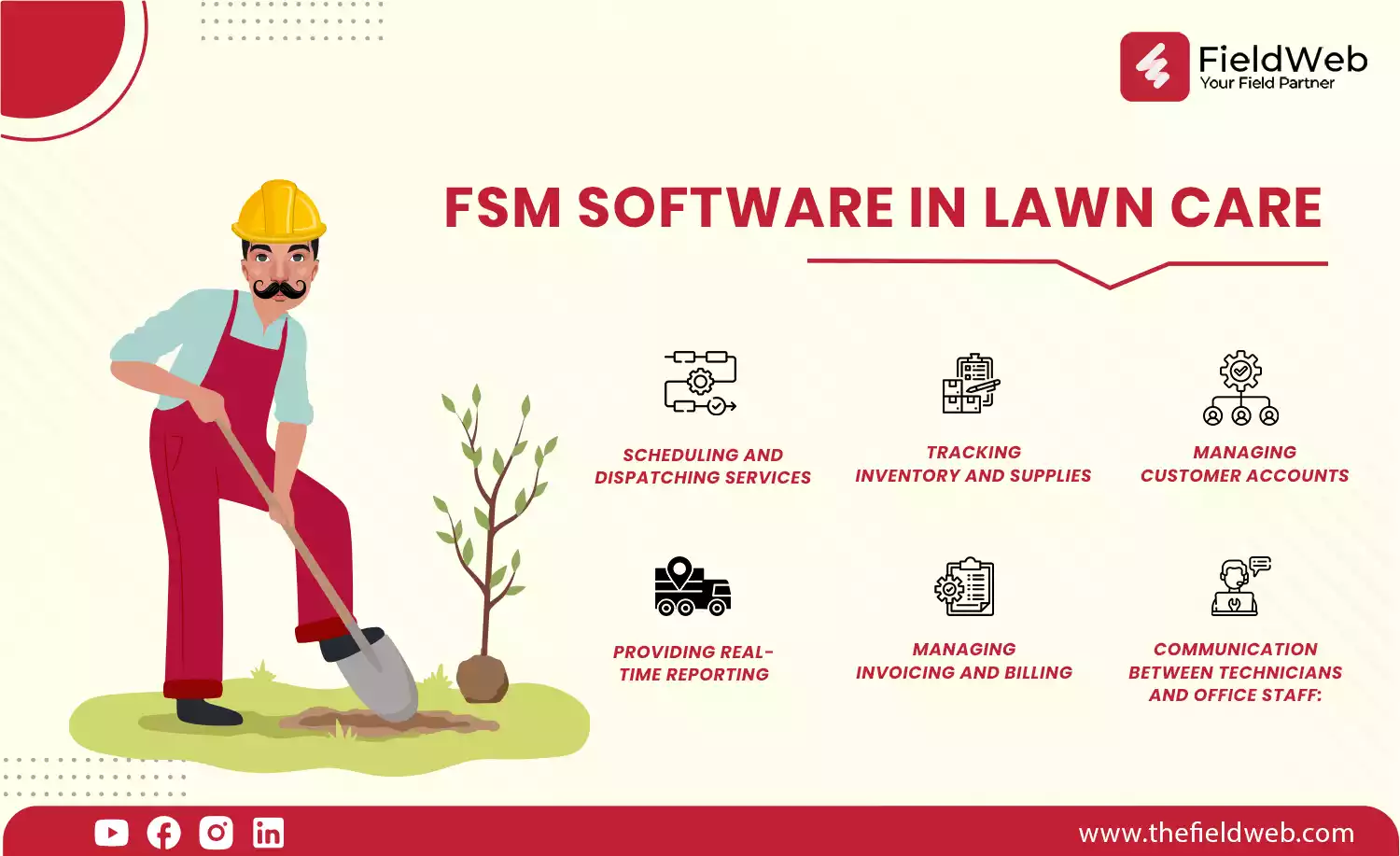
1. Scheduling and dispatching services: FSM software allows you to schedule and dispatch services more efficiently. You can assign tasks to technicians based on their availability, location, and skill set, reducing downtime and increasing productivity. You can also optimize routes to reduce travel time and fuel costs.
2. Tracking inventory and supplies: FSM software can help you track inventory and supplies, ensuring that you have the necessary materials to provide your services. You can set up automatic alerts to notify you when inventory levels are low, so you can restock in a timely manner. This can help you avoid delays in providing services and improve customer satisfaction.
3. Managing customer accounts and invoicing: FSM software can help you manage customer accounts and invoicing more efficiently. You can create invoices automatically based on completed services, and send them to customers via email or mail. You can also track payments and send reminders to customers who have outstanding balances. This can help you get paid faster and reduce the administrative burden of managing customer accounts.
4. Providing real-time reporting and analytics: FSM software can provide you with real-time reporting and analytics, enabling you to make data-driven decisions about your business. You can track key performance indicators (KPIs) such as revenue, customer satisfaction, and technician productivity, and identify areas for improvement. You can also generate custom reports to share with stakeholders such as investors, lenders, and partners.
5. Improving communication between technicians and office staff: FSM software can improve communication between technicians and office staff, reducing errors and improving customer service. Technicians can use mobile devices to access work orders, record time and materials, and communicate with the office. Office staff can use the software to assign tasks, monitor progress, and communicate with technicians in real time. This can help you provide a better customer experience by reducing delays and improving communication.
In summary, FSM software can help lawn care businesses manage their operations more efficiently, reduce costs, and improve customer satisfaction. By using FSM software to streamline scheduling and dispatching, track inventory and supplies, manage customer accounts and invoicing, provide real-time reporting and analytics, and improve communication between technicians and office staff, lawn care businesses can become more competitive and profitable. FieldWeb FSM is one such software that can help lawn care businesses achieve these benefits.
In conclusion, starting a lawn care business can be a lucrative venture for entrepreneurs with a passion for landscaping and gardening. However, to succeed in this competitive market, you need to have a solid business plan, a well-defined pricing strategy, and a commitment to providing excellent customer service. By following the steps outlined in this guide, you can establish a profitable lawn care business that meets the needs of your customers and provides you with a steady stream of income.
It's also worth noting that technology can play a significant role in the success of your lawn care business. FSM software, such as FieldWeb FSM, can help you streamline your operations, improve efficiency, and provide a better customer experience. By using FSM software to schedule and dispatch services, track inventory and supplies, manage customer accounts and invoicing, provide real-time reporting and analytics, and improve communication between technicians and office staff, you can optimize your operations, reduce costs, and increase revenue.
Ultimately, whether you choose to use FSM software or not, the success of your lawn care business will depend on your ability to provide high-quality services, build strong relationships with your customers, and continuously improve your operations. With the right mindset and a commitment to excellence, you can build a thriving lawn care business that provides you with a sense of fulfillment and financial stability.